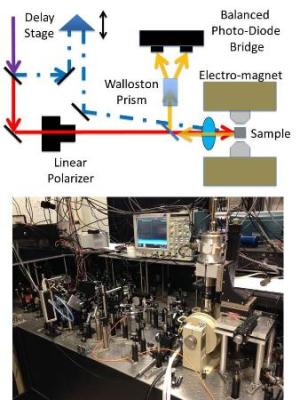Feb 19 2015
Researchers at Western Michigan University and the University of Michigan are studying a group of novel materials that could reduce power consumption and create higher computational speeds even in adverse conditions.
 A laser pulse is split into two paths: circularly polarized pump (blue) and linearly polarized probe (red). The pump's path length is adjustable using a delay stage so that the relative arrival time between the pump and probe can be adjusted. After the probe is reflected from the sample surface, the light is passed through a Walloston Prism and sent to a balanced photo-diode bridge. This allows for very sensitive measurements of the Faraday rotation due to electron spin polarizations. Credit: AIP Publishing
A laser pulse is split into two paths: circularly polarized pump (blue) and linearly polarized probe (red). The pump's path length is adjustable using a delay stage so that the relative arrival time between the pump and probe can be adjusted. After the probe is reflected from the sample surface, the light is passed through a Walloston Prism and sent to a balanced photo-diode bridge. This allows for very sensitive measurements of the Faraday rotation due to electron spin polarizations. Credit: AIP Publishing
A large number of current electronic circuitry depends on controlling electronic charge inside a circuit; however, radiation can easily disrupt this control and interrupt data processing. Spintronics or electronics that utilize spin-based logic may provide an alternative solution that is relatively strong even in environments filled with radiation.
In order to make a spintronic device which is resistant to radiation, a material appropriate for spintronic applications is required so that it can sustain its spin-dependence after irradiation. The Michigan researchers have described their study results in a paper published in the journal, Applied Physics Letters.
Present-day electronic devices utilize charges to store and transmit data, mainly based upon the number of electrons present in one location or another. When a large amount of electrons exist at a specified terminal, it can be called 'on'. If a few electrons exist at the same terminal, it can be called 'off', similar to a light switch. This enables a binary logic based on whether the terminal is 'on/off'. Spintronics employs the 'on/off' concept, but their spin is calculated instead of counting the number of electrons.
You can think of the spin of an electron as a tiny bar magnet with an arrow painted on it. If the arrow points up, we call that 'spin-up'. If it points down, we call that 'spin-down'. By using light, electric, or magnetic fields, we can manipulate, and measure, the spin direction.
Brennan Pursley, first author of the study
Although spintronics could pave the way for efficient and faster computation, researchers are attempting to find out whether it would be effective in adverse settings. At present, radioactivity poses a significant problem for electronic circuitry as it can disrupt data and degrade electronic properties over time. Spintronics can prove effective for short term effects, given that radioactivity can alter the amount of charge in a circuit, but would not impact spin-polarized carriers.
While studying spintronic materials, the researchers would need to integrate the study of radiation damage and the study of spin dynamics. Both sets of tools are powerful and have been around for many years. However, combining these two established fields proved to be a challenging prospect as vast amounts of radiation damage research had to be studied in detail.
That was the most difficult aspect. It was an entirely new field for us with a variety of established techniques and terminology to learn. The key was to tackle it like any new project: ask a lot of questions, find a few good books or papers, and follow the citations.
Brennan Pursley, first author of the study
The Michigan research team determined the n-GaAs’ spin properties as a virtue of radiation fluence using photoluminescence spectroscopy and time-resolved Kerr rotation. Results demonstrate that the g-factor of bulk n-GaAs and the spin lifetime are not considerably affected by proton irradiation, thus making it a suitable contender for additional analysis of spintronic devices. The researchers intend to explore other types of spintronic materials and model devices after irradiation, given that the hybrid field of irradiated spintronics still remains a mystery.
A better understanding of radiation effects on spintronic devices would help in designing such devices. A viable solution would be to process on a communications satellite where electronics can be affected by solar radiation in the absence of Earth's atmosphere. It is possible to integrate the theoretically achievable low power consumption and computation speeds with compact designs and light shielding. Such an approach can help in implementing faster, cheaper and durable communications systems.